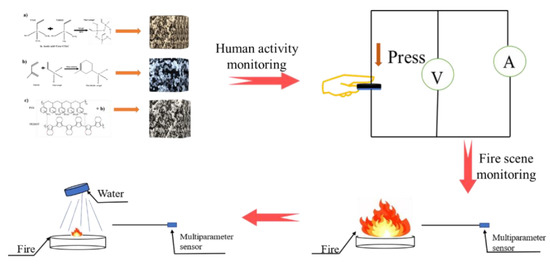Ultrasensitive and Self-Powered Multiparameter Pressure–Temperature–Humidity Sensor Based on Ultra-Flexible Conductive Silica Aerogel
Abstract
:1. Introduction
2. Results and Discussion
2.1. Compositional Analysis
2.2. Experimental Methodology
2.3. Pressure Sensing
2.4. Temperature Sensing
2.5. Humidity Sensing
2.6. Self-Powered Multiparameter Sensing Analysis
3. Detecting Capability of the Self-Powered Multiparameter Sensor
3.1. Human Activity Monitoring
3.2. Fire Scene Monitoring
4. Conclusions
5. Materials and Methods
5.1. Materials
5.2. Sample Preparation
5.3. Characterization of Samples
Supplementary Materials
Author Contributions
Funding
Data Availability Statement
Acknowledgments
Conflicts of Interest
References
- Mohanan, J.L.; Arachchige, I.U.; Brock, S.L. Porous Semiconductor Chalcogenide Aerogels. Science 2005, 307, 397–400. [Google Scholar] [CrossRef]
- Dorcheh, A.S.; Abbasi, M.H. Silica aerogel; synthesis, properties and characterization. J. Mater. Process. Technol. 2008, 199, 10–26. [Google Scholar] [CrossRef]
- Kocon, L.; Despetis, F.; Phalippou, J. Ultralow density silica aerogels by alcohol supercritical drying. J. Non-Cryst. Solids 1998, 225, 96–100. [Google Scholar] [CrossRef]
- Hüsing, N.; Schubert, U. Aerogels—Airy Materials: Chemistry, Structure, and Properties. Angew. Chem. Int. Ed. 1998, 37, 22–45. [Google Scholar] [CrossRef]
- Du, A.; Zhou, B.; Zhang, Z.; Shen, J. A Special Material or a New State of Matter: A Review and Reconsideration of the Aerogel. Materials 2013, 6, 941–968. [Google Scholar] [CrossRef] [Green Version]
- Rao, A.V.; Bhagat, S.D.; Hirashima, H.; Pajonk, G.M. Synthesis of flexible silica aerogels using methyltrimethoxysilane (MTMS) precursor. J. Colloid Interface Sci. 2006, 300, 279–285. [Google Scholar]
- Capadona, L.A.; Meador, M.; Alunni, A.; Fabrizio, E.F.; Vassilaras, P.; Leventis, N. Flexible, low-density polymer crosslinked silica aerogels. Polymer 2006, 47, 5754–5761. [Google Scholar] [CrossRef]
- Katti, A.; Shimpi, N.; Roy, S.; Lu, H.; Leventis, N. Chemical, Physical, and Mechanical Characterization of Isocyanate Cross-linked Amine-Modified Silica Aerogels. Chem. Mater. 2006, 18, 285–296. [Google Scholar] [CrossRef]
- He, S.; Ruan, C.; Shi, Y.; Chen, G.; Ma, Y.; Dai, H.; Chen, X.; Yang, X. Insight to hydrophobic SiO2 encapsulated SiO2 gel: Preparation and application in fire extinguishing. J. Hazard. Mater. 2020, 405, 124216. [Google Scholar] [CrossRef]
- Chen, G.; He, S.; Shi, G.; Ma, Y.; Ruan, C.; Jin, X.; Chen, Q.; Liu, X.; Dai, H.; Chen, X.; et al. In-situ immobilization of ZIF-67 on wood aerogel for effective removal of tetracycline from water. Chem. Eng. J. 2021, 423, 130184. [Google Scholar] [CrossRef]
- Boland, C.S.; Khan, U.; Ryan, G.; Barwich, S.; Charifou, R.; Harvey, A.; Backes, C.; Li, Z.; Ferreira, M.S.; Möbius, M.E.; et al. Sensitive electromechanical sensors using viscoelastic graphene-polymer nanocomposites. Science 2016, 354, 1257–1260. [Google Scholar] [CrossRef]
- Wu, Y.; Yi, N.; Huang, L.; Zhang, T.; Fang, S.; Chang, H.; Li, N.; Oh, J.; Lee, J.A.; Kozlov, M.; et al. Three-dimensionally bonded spongy graphene material with super compressive elasticity and near-zero Poisson’s ratio. Nat. Commun. 2015, 6, 6141. [Google Scholar] [CrossRef] [Green Version]
- Worsley, M.A.; Pham, T.T.; Yan, A.; Shin, S.J.; Lee, J.; Bagge-Hansen, M.; Mickelson, W.; Zettl, A. Synthesis and Characterization of Highly Crystalline Graphene Aerogels. ACS Nano 2014, 8, 11013–11022. [Google Scholar] [CrossRef] [Green Version]
- Moreno, L.; Merlos, A.; Abramova, N.; Jiménez, C.; Bratov, A. Multi-sensor array used as an “electronic tongue” for mineral water analysis. Sens. Actuators B. Chem. 2005, 116, 130–134. [Google Scholar] [CrossRef]
- Maluf, K.S.; Morley, R.E.; Richter, E.J.; Klaesner, J.W.; Mueller, M.J. Monitoring in-shoe plantar pressures, temperature, and humidity: Reliability and validity of measures from a portable device. Arch. Phys. Med. Rehabil. 2001, 82, 1119–1127. [Google Scholar] [CrossRef]
- Smith, R.L.; Scott, D.C. An Integrated Sensor for Electrochemical Measurements. IEEE Trans. Bio-Med. Eng. 1986, 33, 83–90. [Google Scholar] [CrossRef]
- Li, F.; Zhu, H.; Wu, H. Farmland Multiparameter Wireless Sensor Network Data Compression Strategy. Int. J. Ad Hoc Ubiquitous Comput. 2018, 1, 1. [Google Scholar] [CrossRef]
- Horii, T.; Hikawa, H.; Katsunuma, M.; Okuzaki, H. Synthesis of highly conductive PEDOT:PSS and correlation with hierarchical structure. Polym. Int. J. Sci. Technol. Polym. 2018, 140, 33–38. [Google Scholar] [CrossRef]
- Du, C.; Chen, Y.; He, S.; Ruan, C.; Liu, X.; He, C.; Jin, X.; Chen, Q. Insight into ultra-flexible & robust silica aerogels based on diene synthesis reaction: Preparation and oil/water separation. Appl. Surf. Sci. 2022, 606, 154902. [Google Scholar]
- Zhou, J.; Hsieh, Y.L. Conductive Polymer Protonated Nanocellulose Aerogels for Tunable and Linearly Responsive Strain Sensors. ACS Appl. Mater. Interfaces 2018, 10, 27902–27910. [Google Scholar] [CrossRef] [Green Version]
- Shaobo, H.; Fei, J.; Ullah, K.Z.; Jesper, E.; Simone, F.; Xavier, C. Thermoelectric Polymer Aerogels for Pressure–Temperature Sensing Applications. Adv. Funct. Mater. 2017, 27, 1703549. [Google Scholar]
- Hou, Y.; Wang, L.; Sun, R.; Zhang, Y.; Gu, M.; Zhu, Y.; Tong, Y.; Liu, X.; Wang, Z.; Xia, J. Crack-Across-Pore Enabled High-Performance Flexible Pressure Sensors for Deep Neural Network Enhanced Sensing and Human Action Recognition. ACS Nano 2022, 16, 8358–8369. [Google Scholar] [CrossRef]
- Lee, B.S.; Yang, H.S.; Jung, H.; Jeon, S.Y.; Jung, C.; Kim, S.W.; Bae, J.; Choong, C.L.; Im, J.; Chung, U.I. Novel multi-layered 1-D nanostructure exhibiting the theoretical capacity of silicon for a super-enhanced lithium-ion battery. Nanoscale 2014, 6, 5989–5998. [Google Scholar] [CrossRef]
- Trung, T.Q.; Tien, N.T.; Seol, Y.G.; Lee, N.E. Transparent and flexible organic field-effect transistor for multi-modal sensing. Org. Electron. 2012, 13, 533–540. [Google Scholar] [CrossRef]
- Zhu, S.E.; Ghatkesar, M.K.; Chao, Z.; Janssen, G. Graphene based piezoresistive pressure sensor. Appl. Phys. Lett. 2013, 102, 161904. [Google Scholar] [CrossRef] [Green Version]
- Graz, I.; Krause, M.; Bauer-Gogonea, S.; Bauer, S.; Lacour, S.P.; Ploss, B.; Zirkl, M.; Stadlober, B.; Wagner, S. Flexible active-matrix cells with selectively poled bifunctional polymer-ceramic nanocomposite for pressure and temperature sensing skin. J. Appl. Phys. 2009, 106, 447. [Google Scholar] [CrossRef]
- Joshi, A.B.; Kalange, A.E.; Bodas, D.; Gangal, S.A. Simulations of piezoelectric pressure sensor for radial artery pulse measurement. Mater. Sci. Eng. B 2010, 168, 250–253. [Google Scholar] [CrossRef]
- Gong, S.; Schwalb, W.; Wang, Y.; Chen, Y.; Tang, Y.; Si, J.; Shirinzadeh, B.; Cheng, W. A wearable and highly sensitive pressure sensor with ultrathin gold nanowires. Nat. Commun. 2014, 5, 3132. [Google Scholar] [CrossRef] [Green Version]
- Tan, Q.; Chen, L.; Xiong, J.; Jia, P.; Tao, L. A High Temperature Capacitive Pressure Sensor Based on Alumina Ceramic for in Situ Measurement at 600 °C. Sensors 2014, 14, 2417–2430. [Google Scholar] [CrossRef] [Green Version]
- Kim, J.; Ng, T.N.; Kim, W.S. Highly sensitive tactile sensors integrated with organic transistors. Appl. Phys. Lett. 2012, 5, 460–1358. [Google Scholar] [CrossRef]
- Ramuz, M.; Tee, C.K.; Tok, B.H.; Bao, Z. Transparent, Optical, Pressure-Sensitive Artificial Skin for Large-Area Stretchable Electronics. Adv. Mater. 2012, 24, 3223–3227. [Google Scholar] [CrossRef]
- Mannsfeld, S.; Tee, C.K.; Stoltenberg, R.M.; Chen, H.H.; Barman, S.; Muir, B.; Sokolov, A.N.; Reese, C.; Bao, Z. Highly sensitive flexible pressure sensors with microstructured rubber dielectric layers. Nat. Mater. 2010, 9, 859–864. [Google Scholar] [CrossRef]
- Uchida, K.; Takahashi, S.; Harii, K.; Ieda, J.; Koshibae, W.; Ando, K.; Maekawa, S.; Saitoh, E. Observation of the Spin Seebeck Effect. Nature 2008, 40, 778–781. [Google Scholar] [CrossRef]
- Wang, M.; Anoshkin, I.V.; Nasibulin, A.G.; Korhonen, J.T.; Seitsonen, J.; Pere, J.; Kauppinen, E.I.; Ras, R.; Ikkala, O. Modifying native nanocellulose aerogels with carbon nanotubes for mechanoresponsive conductivity and pressure sensing. Adv. Mater. 2013, 25, 2428–2432. [Google Scholar] [CrossRef]
- Ouyang, L.; Musumeci, C.; Jafari, M.J.; Ederth, T.; Inganas, O. Imaging the Phase Separation Between PEDOT and Polyelectrolytes During Processing of Highly Conductive PEDOT:PSS Films. ACS Appl. Mater. Interfaces 2015, 7, 19764–19773. [Google Scholar] [CrossRef]
- Herwaarden, A.W. Thermal sensors based on the seebeck effect. Sens. Actuators 1986, 10, 321–346. [Google Scholar] [CrossRef]
- Zhang, F.; Zang, Y.; Huang, D.; Di, C.-A.; Zhu, D. Flexible and self-powered temperature–pressure dual-parameter sensors using microstructure-frame-supported organic thermoelectric materials. Nat. Commun. 2015, 6, 8356. [Google Scholar] [CrossRef]
- Jakobsson, F.; Crispin, X.; Lindell, L.; Kanciurzewska, A.; Fahlman, M.; Salaneck, W.R.; Berggren, M. Towards all-plastic flexible light emitting diodes. Chem. Phys. Lett. 2006, 433, 110–114. [Google Scholar] [CrossRef]
- He, S.; Huang, Y.; Chen, G.; Feng, M.; Dai, H.; Yuan, B.; Chen, X. Effect of heat treatment on hydrophobic silica aerogel. J. Hazard. Mater. 2019, 362, 294–302. [Google Scholar] [CrossRef]
- Jin, Y.; Chen, Q.; Lessner, P. Thermal Stability Investigation of PEDOT Films from Chemical Oxidation and Prepolymerized Dispersion. Electrochemistry 2013, 81, 801–803. [Google Scholar] [CrossRef] [Green Version]
- Zhao, H.; Zhang, T.; Qi, R.; Dai, J.; Liu, S.; Fei, T. Drawn on Paper: A Reproducible Humidity Sensitive Device by Handwriting. ACS Appl. Mater. Interfaces 2017, 9, 28002–28009. [Google Scholar] [CrossRef] [PubMed]
- Zhu, P.; Liu, Y.; Fang, Z.; Kuang, Y.; Zhang, Y.; Peng, C.; Chen, G. Flexible and Highly Sensitive Humidity Sensor Based on Cellulose Nanofibers and Carbon Nanotube Composite Film. Langmuir ACS J. Surf. Colloids 2019, 35, 4834–4842. [Google Scholar] [CrossRef] [PubMed]
- Zhang, D.; Tong, J.; Xia, B. Humidity-sensing properties of chemically reduced graphene oxide/polymer nanocomposite film sensor based on layer-by-layer nano self-assembly. Sens. Actuators B. Chem. 2014, 197, 66–72. [Google Scholar] [CrossRef]
- Duan, Z.; Jiang, Y.; Yan, M.; Wang, S.; Tai, H. Facile, Flexible, Cost-Saving and Environment-Friendly Paper-Based Humidity Sensor for Multifunctional Applications. ACS Appl. Mater. Interfaces 2019, 11, 21840–21849. [Google Scholar] [CrossRef]
- Pzae, F.; Ykbc, D.; Yuan, W.; Fang, L.; Hoa, E.; Feng, J.F.; Gang, C. Electrostatic self-assembly enabled flexible paper-based humidity sensor with high sensitivity and superior durability. Chem. Eng. J. 2021, 404, 127105. [Google Scholar]
- Jing, Z.; Na, L.; Hua, Y.; Zheng, W.; Liao, M.; Peng, C.; Wang, S.; Shi, D.; Sun, Q.; Zhang, G. Highly Sensitive MoS2 Humidity Sensors Array for Noncontact Sensation. Adv. Mater. 2017, 29, 1702076. [Google Scholar]
- Tang, Q.Y.; Chan, Y.C.; Zhang, K. Fast response resistive humidity sensitivity of polyimide/multiwall carbon nanotube composite films. Sens. Actuators 2011, 152, 99–106. [Google Scholar] [CrossRef]
- He, S.; Chen, G.; Xiao, H.; Shi, G.; Ruan, C.; Ma, Y.; Dai, H.; Yuan, B.; Chen, X.; Yang, X. Facile preparation of N-doped activated carbon produced from rice husk for CO2 capture. J. Colloid Interface Sci. 2021, 582 Pt 1, 90–101. [Google Scholar] [CrossRef]
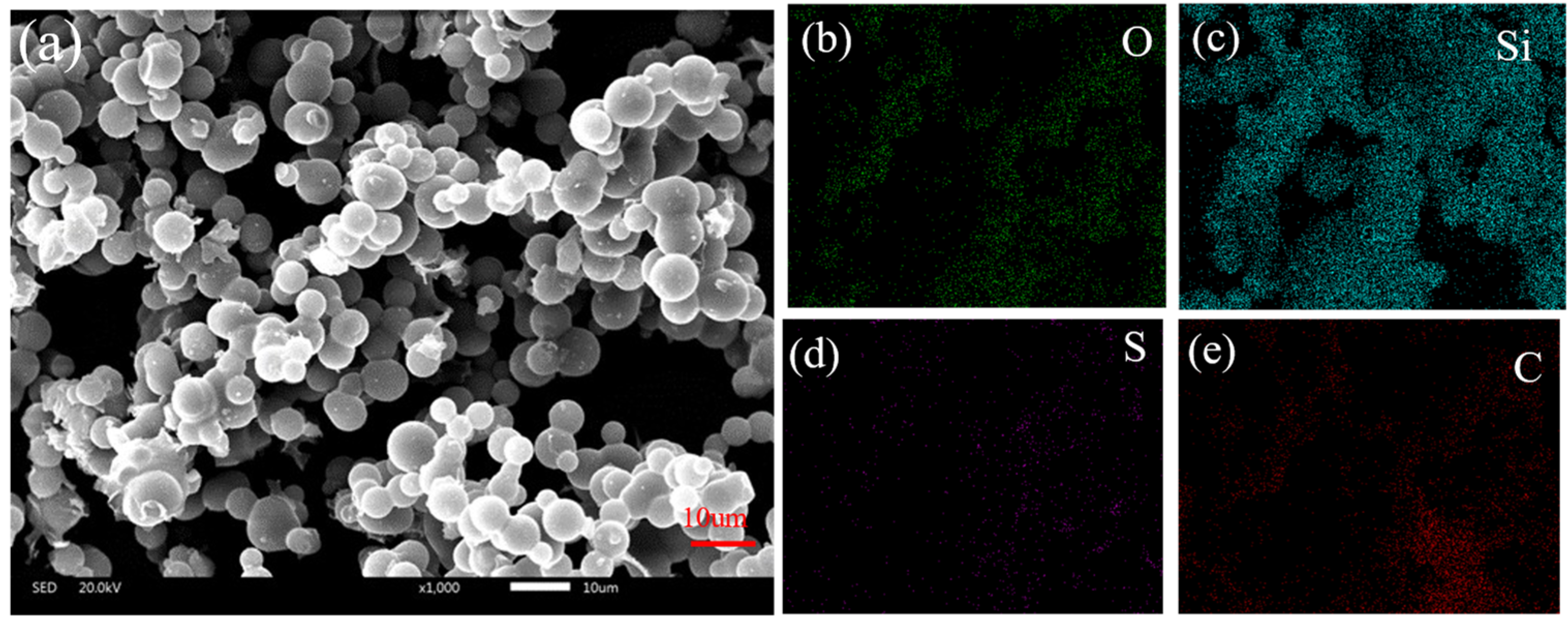
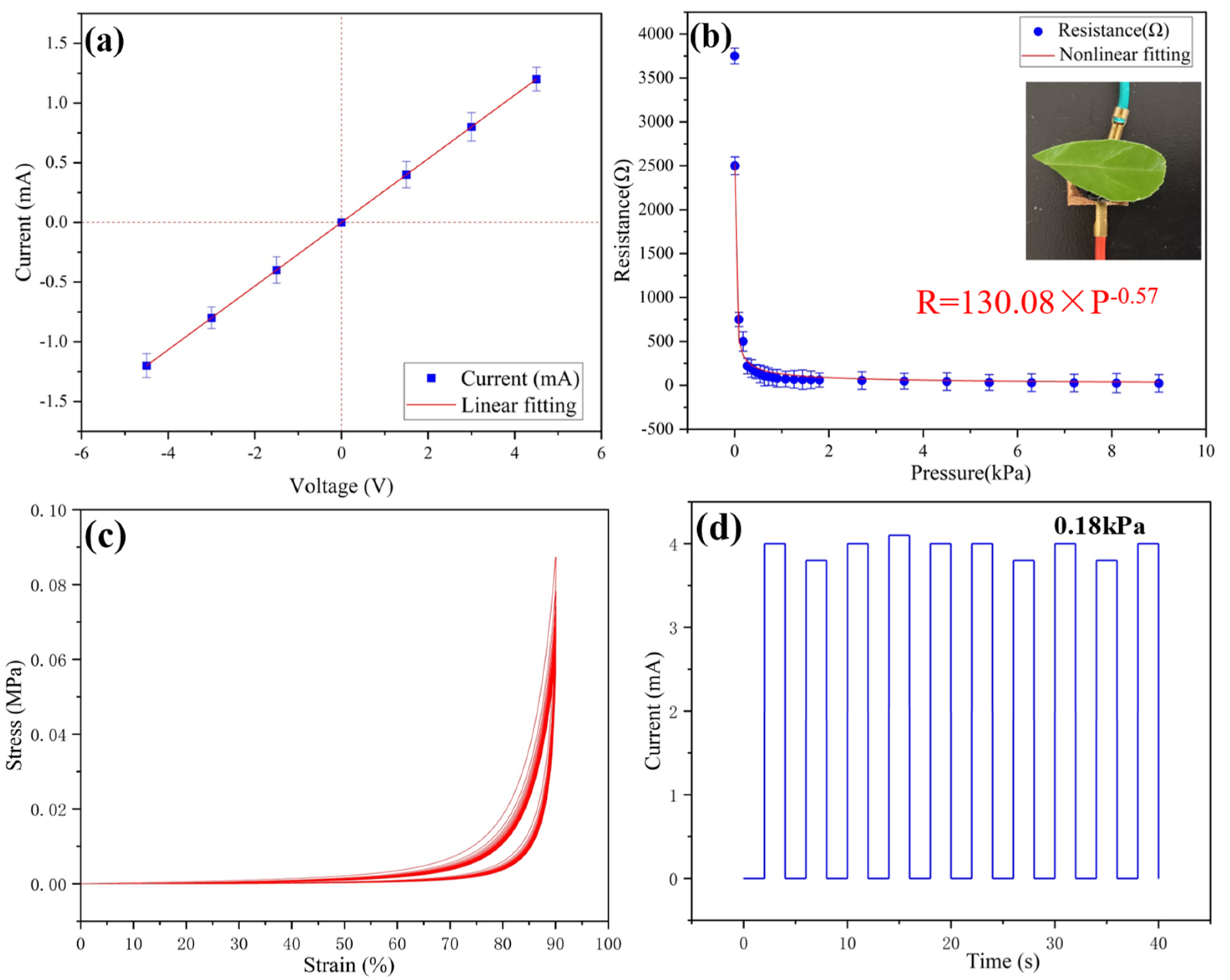


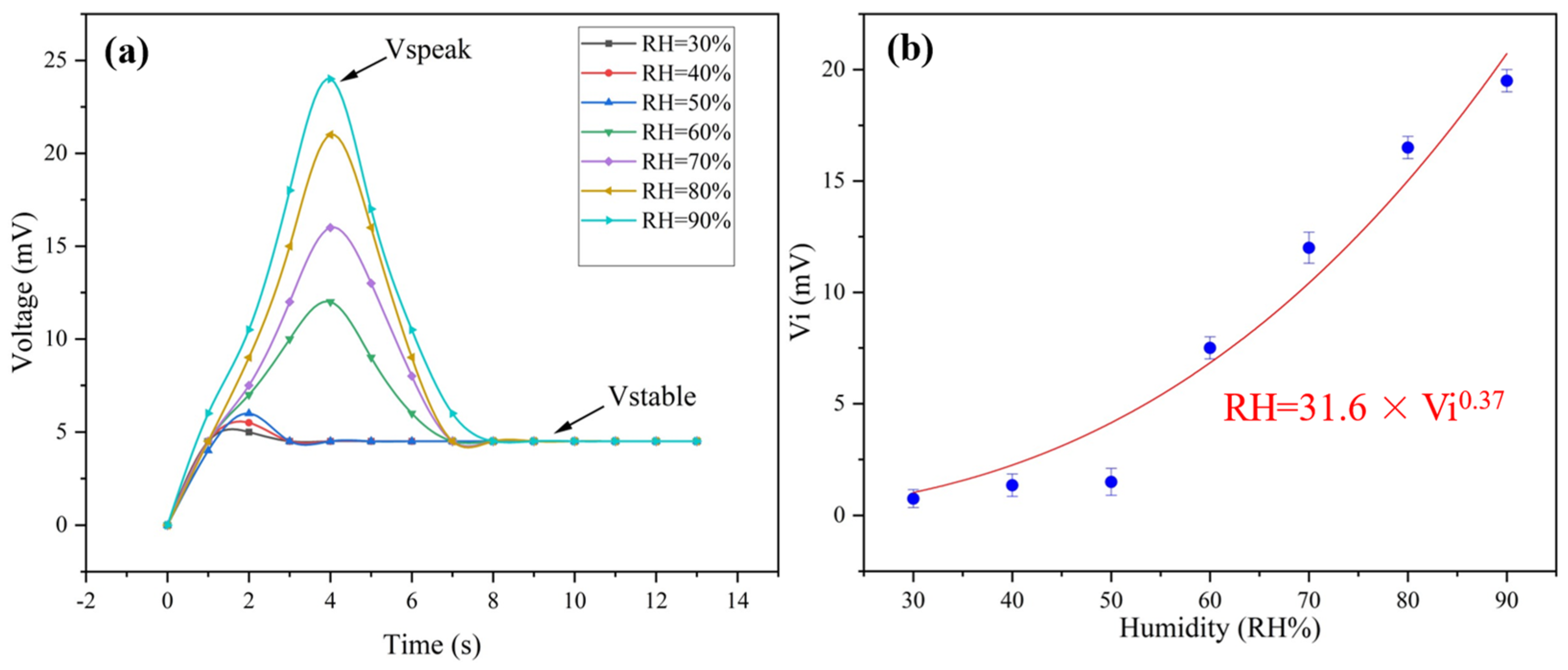
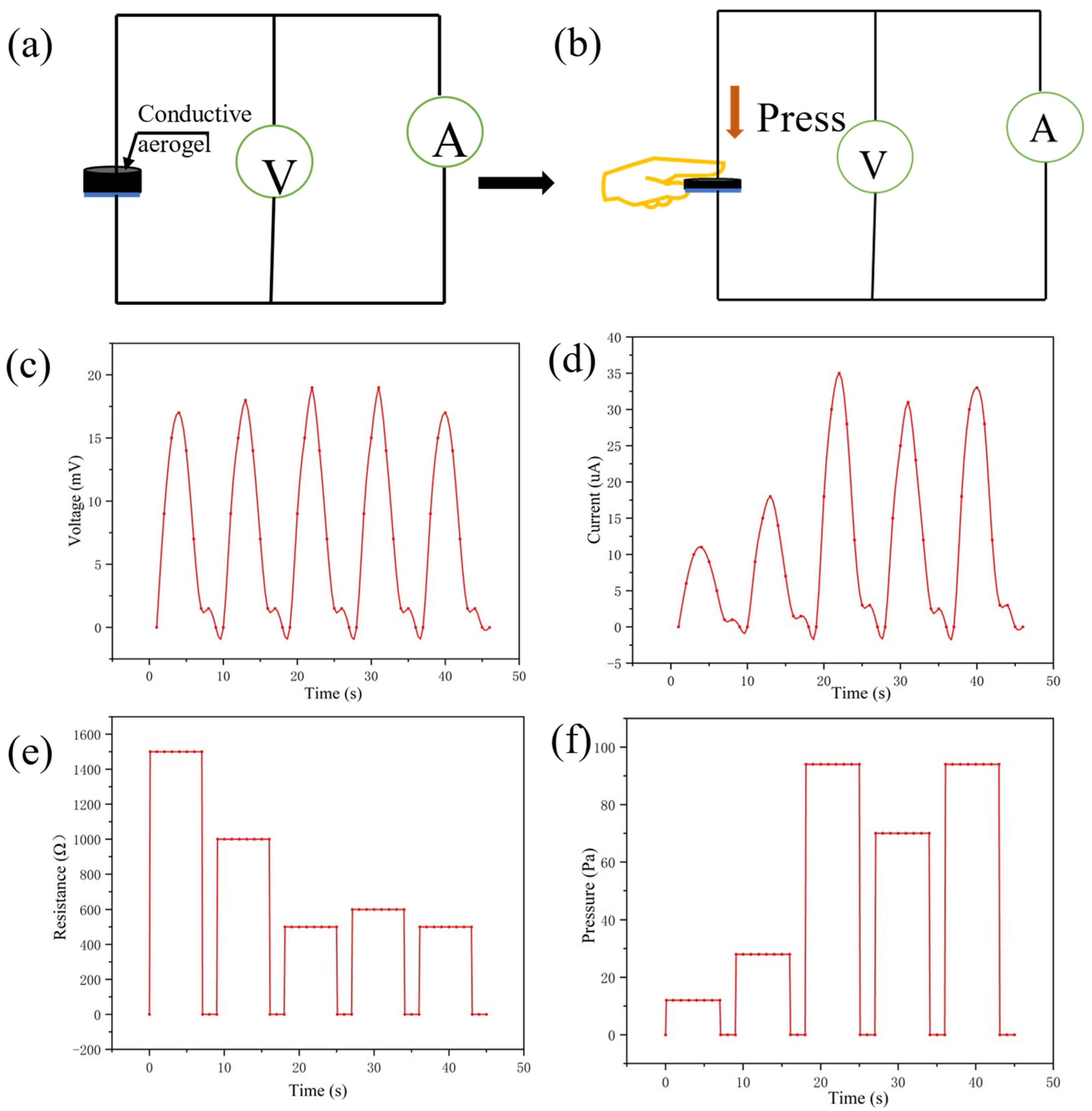


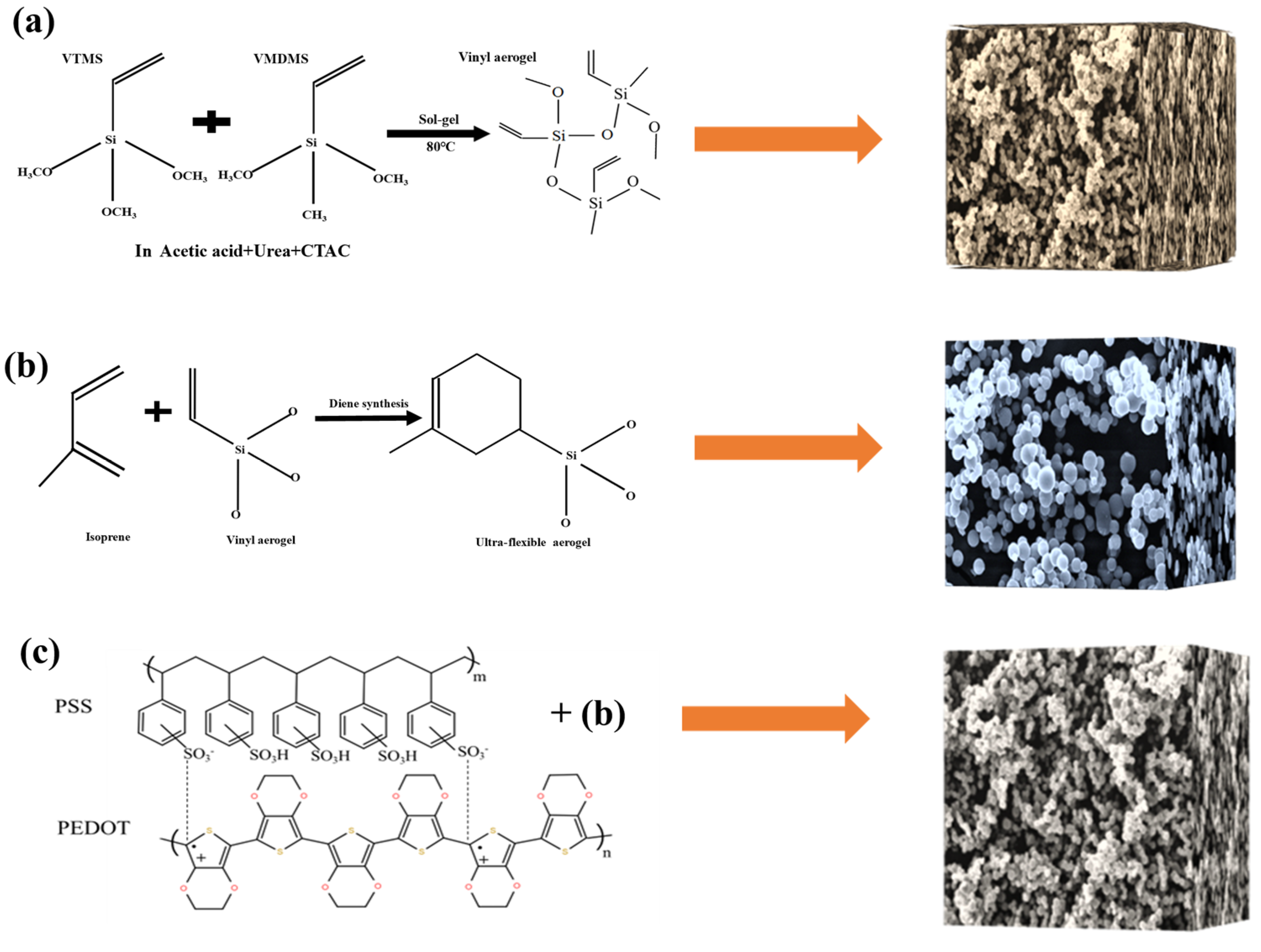
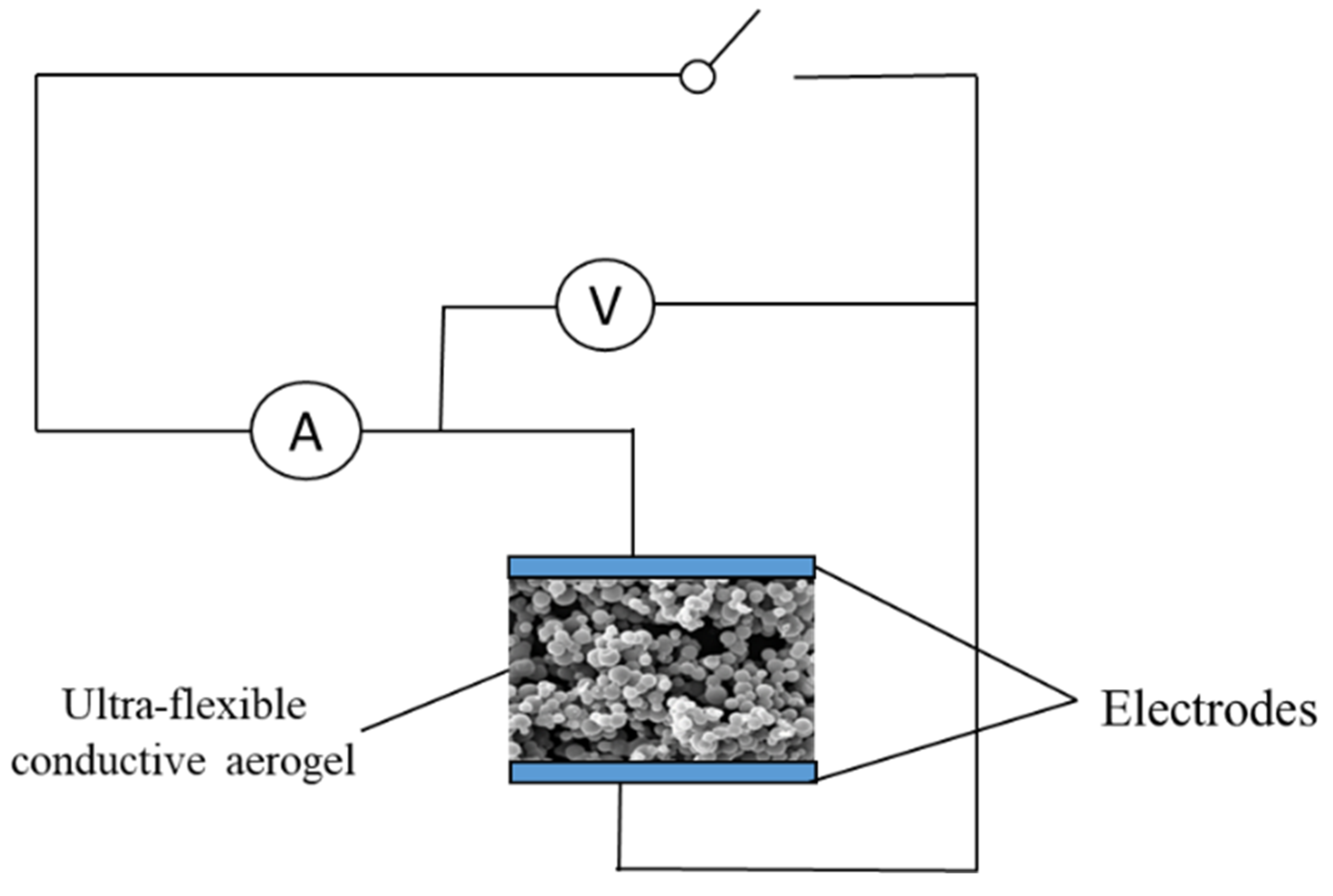
| Samples | Si | C | O | S |
|---|---|---|---|---|
| Aerogel without PEDOT:PSS | 30.59 | 46.20 | 23.00 | 0.00 |
| Aerogel with PEDOT:PSS | 24.21 | 53.28 | 21.27 | 0.81 |
| Type of Sensor | Materials | Sensitivity | Limit of Detection | Reference |
|---|---|---|---|---|
| Piezoresistivity | VMDM, VTMS/PEDOT:PSS | 54.88 kPa−1 | 5 Pa | This work |
| Piezoresistivity | PDMS/PEDOT:PSS/PUD | 10.32 kPa−1 | 23 Pa | [23] |
| Piezoelectricity/OFET | P (VDF-TrFE) | - | 200 kPa | [24] |
| Piezoresistivity | Graphene | - | 100 Pa | [25] |
| Piezoelectricity | Titanate/P (VDF-TrFE) | 7 × 10−4 kPa−1 | 200 kPa | [26] |
| Piezoelectricity | PVDF | 2 V kPa−1 | 1 kPa | [27] |
| Piezoresistivity | Tissue/Gold nanowires | 1.14 kPa−1 | 13 Pa | [28] |
| Capacitance | Alumina ceramic | 0.0035 kPa−1 | 100 kPa | [29] |
| Capacitance/OFET | PS-b-P2VP | 1.76 kPa−1 | 17 Pa | [30] |
| Optical waveguide | PDMS | 0.2 kPa−1 | <1 kPa | [31] |
| Capacitance/OFET | PDMS/Rubrene | 0.55 kPa−1 | 3 Pa | [32] |
| Materials | Fabrication | Output Signal | Response Time | Reference |
|---|---|---|---|---|
| VMDMS, VTMS/PEDOT:PSS | Soakage | current | 4 s | This work |
| MWCNTs on paper | Drawing | current | 470 s | [41] |
| CNF/MWCNTs | vacuum filtration | current | 330 s | [42] |
| RGO/PDDA | layer-by-layer self-assembly | resistive | 108 s | [43] |
| Paper | tape-attached | current | 472 s | [44] |
| CNF/MWCNTs | vacuum filtration | current | 333 s | [45] |
| MoS2 | CVD | resistive | 10 s | [46] |
| CNT/PI | in situ polymerization | resistive | 5 s | [47] |
Disclaimer/Publisher’s Note: The statements, opinions and data contained in all publications are solely those of the individual author(s) and contributor(s) and not of MDPI and/or the editor(s). MDPI and/or the editor(s) disclaim responsibility for any injury to people or property resulting from any ideas, methods, instructions or products referred to in the content. |
© 2023 by the authors. Licensee MDPI, Basel, Switzerland. This article is an open access article distributed under the terms and conditions of the Creative Commons Attribution (CC BY) license (https://creativecommons.org/licenses/by/4.0/).
Share and Cite
He, S.; Du, C.; Sheng, H.; He, C.; Liu, X.; Jin, X.; Chen, Q.; Tian, F. Ultrasensitive and Self-Powered Multiparameter Pressure–Temperature–Humidity Sensor Based on Ultra-Flexible Conductive Silica Aerogel. Gels 2023, 9, 162. https://doi.org/10.3390/gels9020162
He S, Du C, Sheng H, He C, Liu X, Jin X, Chen Q, Tian F. Ultrasensitive and Self-Powered Multiparameter Pressure–Temperature–Humidity Sensor Based on Ultra-Flexible Conductive Silica Aerogel. Gels. 2023; 9(2):162. https://doi.org/10.3390/gels9020162
Chicago/Turabian StyleHe, Song, Chunhua Du, Hongliang Sheng, Chunxiang He, Xinyu Liu, Xin Jin, Qilin Chen, and Fuliang Tian. 2023. "Ultrasensitive and Self-Powered Multiparameter Pressure–Temperature–Humidity Sensor Based on Ultra-Flexible Conductive Silica Aerogel" Gels 9, no. 2: 162. https://doi.org/10.3390/gels9020162




